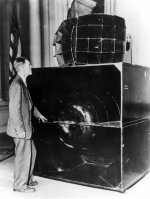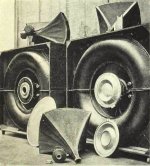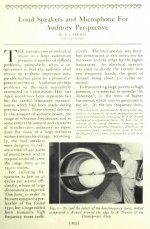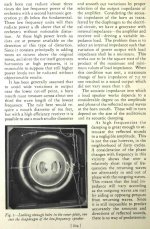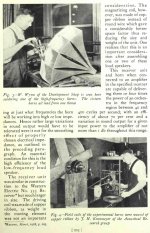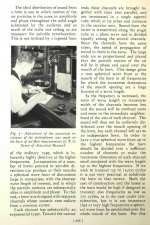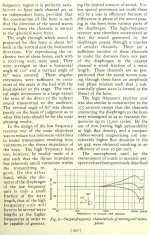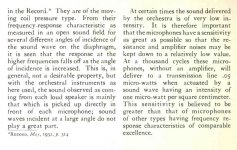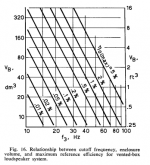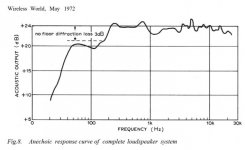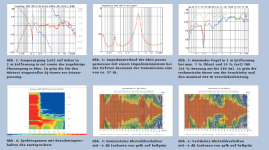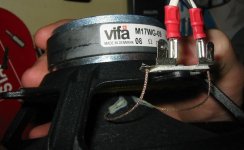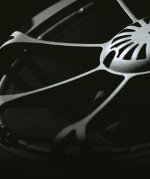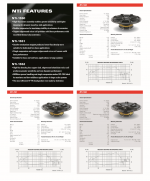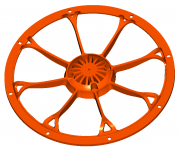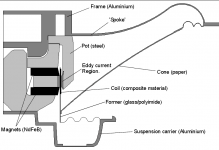2-way, fully hornloaded, (semi-)time-aligned, nearly 85-year-old loudspeaker system.
Loud Speaker for Auditory Perspective by E. C. Wente and A. L. Thuras (1934).
The Fletcher system was the father of the Shearer sound system and all those to come.
(Courtesy of itshifi.com)
In the comment section, someone posted:
"In 1971 or 1972, I got a look at these speakers in the basement of the Seeley W. Mudd building at Columbia University. By the way, the metal diaphragm pictured in the lower right is 20 inches in diameter. The attached voice coil is 8 inches in diameter.
At that time, custodians reported that these and other artifacts were being taken out of storage and disposed of or otherwise moved to other locations. These kind souls actually gave me a General Radio 723-C 1000Hz vacuum tube tuning fork based frequency standard. When I asked about the availability of the horn loudspeakers, they rolled their eyes and said, "No, there are plans to preserve and keep those." So I assume they are still around somewhere."
Loud Speaker for Auditory Perspective by E. C. Wente and A. L. Thuras (1934).
The Fletcher system was the father of the Shearer sound system and all those to come.
(Courtesy of itshifi.com)
In the comment section, someone posted:
"In 1971 or 1972, I got a look at these speakers in the basement of the Seeley W. Mudd building at Columbia University. By the way, the metal diaphragm pictured in the lower right is 20 inches in diameter. The attached voice coil is 8 inches in diameter.
At that time, custodians reported that these and other artifacts were being taken out of storage and disposed of or otherwise moved to other locations. These kind souls actually gave me a General Radio 723-C 1000Hz vacuum tube tuning fork based frequency standard. When I asked about the availability of the horn loudspeakers, they rolled their eyes and said, "No, there are plans to preserve and keep those." So I assume they are still around somewhere."
Attachments
Last edited:
😉
"A properly sized and designed exponential horn, a consistent design, is a non-resonant or in other words a highly damped acoustic enclosure. Without the full damping supplied by the mouth, compromised exponential horns exhibit weak quarter wavelength standing waves similar to a transmission line enclosure. This counters one prevailing myth about standing waves in horns; there are no half wavelength standing wave resonances associated with a horn geometry. All longitudinal standing wave resonances in transmission lines and compromised horn geometries exhibit quarter wavelength pressure and velocity distributions."
IOW, once you've optimized the TL's geometry (without stuffing) in such a way it no longer exhibits standing waves, you basically end up with a BLH.
I was thinking that TL is basically an optimized truncated horn, to which if you take a horn and cutoff its mouth flare, you end up with the rippled FR. Then again I only regurgitate stuff I've read recently and my point of view is lacking maturity on the topic =(
=)
I wonder how loud PMC is able to get from such a small TL for a 15. From my time in Horn Resp, I find you can decrease transmission line volume but out put decreases significantly and the TL is already an inefficient design as it is. So, to no surprise, on their website you find no frequency response charts, or even a reported response described as -3, or -10.
Seems like TL would produce good midbass though, maybe its the drivers fault?
Seems like TL would produce good midbass though, maybe its the drivers fault?
I wonder how loud PMC is able to get from such a small TL for a 15.
Which one? The 15" PMC listed earlier must be 15+ ft^3 gross.
GM
It would be much better (and easier!) to focus on having an efficient 50 (or 60Hz) >20KHz range and use a separate sub (or two) for the lower bass:
1)Your mains will be easier to design and build;
2)they will be more compact;
3)there will be less intermodulation distortion (provided you use an active crossover between the main amp and the subs amp);
4)they will play even louder;
5) there will be less strain on the mains amp
6)you will be able to tackle the inevitable non-linearities of the room response much easier;
7) you will be able to place the subs where bass sounds best, and the mains where the rest of the range sounds best (wich is never the same spot!)
1)Your mains will be easier to design and build;
2)they will be more compact;
3)there will be less intermodulation distortion (provided you use an active crossover between the main amp and the subs amp);
4)they will play even louder;
5) there will be less strain on the mains amp
6)you will be able to tackle the inevitable non-linearities of the room response much easier;
7) you will be able to place the subs where bass sounds best, and the mains where the rest of the range sounds best (wich is never the same spot!)
@camplo, the TL I had from this article using the KEF drivers (B139 woofer) had excellent mid bass as well as deep low end. Check out the response with the attachment. I had the Radford FN10 XO, but I would have to dig out the specs to see where the B139 XO frequency was. All I remember is musical bass that went deep effortlessly.
From the article: "As mentioned previously, response curves should be treated with extreme caution as they represent only part of the performance of the speaker. Nevertheless the overall response curve should be as flat as is reasonably possible. The curve for the complete system when measured in an anechoic chamber’ is shown in Fig. 8.
In looking at this curve several points must be noted. First, the falling bass response shown will not occur in the same manner in a room. The presence of a floor will give a 3dB lift due to the absence diffraction in the downward direction. Similarly, wails and ceilings add to the on−axis bass output. In fact a ‘flat’ response in an anechoic chamber will sound very bass heavy when the system is used in a normal room. Under normal room conditions the bass output of system described is quite adequate, windows being easily rattled at 30Hz."
From the article: "As mentioned previously, response curves should be treated with extreme caution as they represent only part of the performance of the speaker. Nevertheless the overall response curve should be as flat as is reasonably possible. The curve for the complete system when measured in an anechoic chamber’ is shown in Fig. 8.
In looking at this curve several points must be noted. First, the falling bass response shown will not occur in the same manner in a room. The presence of a floor will give a 3dB lift due to the absence diffraction in the downward direction. Similarly, wails and ceilings add to the on−axis bass output. In fact a ‘flat’ response in an anechoic chamber will sound very bass heavy when the system is used in a normal room. Under normal room conditions the bass output of system described is quite adequate, windows being easily rattled at 30Hz."
Attachments
Camplo, a tip: be ready to make some prototypes before commiting full finished cabinets. I quarantee you get better speaker with one or more prototypes, which ever topology you choose and how ever good your plan is 😉 Unless you make exact copy of a cabinet you've already heard in your room.
Less volume is always less peak SPL and always trading efficiency for BW:
GM
If you consider >2% efficiency, then >6ft³ will get you in the ballpark.
Which one? The 15" PMC listed earlier must be 15+ ft^3 gross.
GM
I was guessing 13 and yeah, thats small for TM carrying a 15" isn't it? I was looking at something like 21 ft^3 for 18"
PMC doesn't publish measurement data, here's why.
These are anechoic measurements of the PMC I owned, taken from 4m at an acoustics lab by Audio Engineer Prof. Dr.-Ing. Anselm Goertz.
Funny detail: the vifa M17WG-09 mid driver in the PMC is closely related to the vifa drivers used by Lynn Olsen (in the Ariel), Troels Gravesen and Living Voice.
These are anechoic measurements of the PMC I owned, taken from 4m at an acoustics lab by Audio Engineer Prof. Dr.-Ing. Anselm Goertz.
Funny detail: the vifa M17WG-09 mid driver in the PMC is closely related to the vifa drivers used by Lynn Olsen (in the Ariel), Troels Gravesen and Living Voice.
Attachments
Last edited:
Which model is this exactly( ref and year) Ro808?
The one i heard was dsp driven with proprietary amp ( and dsp iirc). Circa 2005/6.
In my memories they didn't had issues in the low end but i wasn't convinced by mid/high.
That said it could be low end related: first time i heard /made comparison with a supertweeter on a known loudspeaker the gain was for me low end related. The stereophonic scene was tighter and more focused and there was a gain in deepness ( of the scene) too.
Not at all what i expected.
The one i heard was dsp driven with proprietary amp ( and dsp iirc). Circa 2005/6.
In my memories they didn't had issues in the low end but i wasn't convinced by mid/high.
That said it could be low end related: first time i heard /made comparison with a supertweeter on a known loudspeaker the gain was for me low end related. The stereophonic scene was tighter and more focused and there was a gain in deepness ( of the scene) too.
Not at all what i expected.
Last edited:
Interesting. Yours were probably from same period as the ones i talked about.
They had not introduced the 'flat' drivers into their line and was lucky to listen them at the time with then french distributor ( which owned and was engineer of a mastering studio where he used as mains... B&W 800 series !( though activated with dsp). The small planar driver Pmc was there for 5.1).
They had not introduced the 'flat' drivers into their line and was lucky to listen them at the time with then french distributor ( which owned and was engineer of a mastering studio where he used as mains... B&W 800 series !( though activated with dsp). The small planar driver Pmc was there for 5.1).
Quite a size difference compared to the BB5 XBD-A, eh?

The BB5 XBD-A is listed for € 145.271,00, about 1000x the price I paid for the DB1S.
Sold 'em after 3 months to a guy who runs a radio station for € 700, but could have sold them for even more.
People tend to be blinded by 'brand image'.

The BB5 XBD-A is listed for € 145.271,00, about 1000x the price I paid for the DB1S.
Sold 'em after 3 months to a guy who runs a radio station for € 700, but could have sold them for even more.
People tend to be blinded by 'brand image'.
Last edited:
Stereophile measurements of pmc ib1’s here FYI: PMC IB-1S loudspeaker Measurements | Stereophile.com
Some time ago I was tempted to buy a bunch of Volt RV3863 drivers for a few hundred €.
Did some modeling of the things and couldn't find any alignment I liked.
The Volt mid dome is quite expensive and hard to get by.
The tweet is an of the shelf SEAS, I believe.
Did some modeling of the things and couldn't find any alignment I liked.
The Volt mid dome is quite expensive and hard to get by.
The tweet is an of the shelf SEAS, I believe.
The Volt woofers always remind me of the short-lived Celestion NTi series, developed in the early 2000s by Mark Dodd - one of the brains behind the Axi2050.
The NTi woofers featured an inverted Neodymium magnet structure in an axisymmetric frame.
"The NTi Inverted Neo range were the first ever professional drive units with this level of power handling to incorporate a
Neodymium magnet structure. This material produces far stronger field effects than traditional ferrite magnets, so the magnet
structure can be made much smaller and lighter while still yielding an extremely impressive frequency response. As a result,
NTi speakers exhibit superb detail at an incredibly low weight.
The front-mounted magnet assembly allows the speaker to operate at a much higher power than would otherwise be possible.
With a conventional back-mounted assembly, heat dissipation from the magnet structure can be limited, causing thermal
effects that impair the performance of the driver. This ‘inverted’ chassis design permits the magnet structure to radiate heat in
free air, giving the best possible cooling.
Other characteristics of the NTi range include double suspension for maximum stability at extremes of excursion and an
edgewound voice coil for enhanced bass performance. The NTi-1552 features a copper-clad aluminium voice coil to reduce
moving mass and inductance, making it, at 100dB sensitivity, the most efficient 15" PA loudspeaker ever made by Celestion."
The NTi woofers featured an inverted Neodymium magnet structure in an axisymmetric frame.
"The NTi Inverted Neo range were the first ever professional drive units with this level of power handling to incorporate a
Neodymium magnet structure. This material produces far stronger field effects than traditional ferrite magnets, so the magnet
structure can be made much smaller and lighter while still yielding an extremely impressive frequency response. As a result,
NTi speakers exhibit superb detail at an incredibly low weight.
The front-mounted magnet assembly allows the speaker to operate at a much higher power than would otherwise be possible.
With a conventional back-mounted assembly, heat dissipation from the magnet structure can be limited, causing thermal
effects that impair the performance of the driver. This ‘inverted’ chassis design permits the magnet structure to radiate heat in
free air, giving the best possible cooling.
Other characteristics of the NTi range include double suspension for maximum stability at extremes of excursion and an
edgewound voice coil for enhanced bass performance. The NTi-1552 features a copper-clad aluminium voice coil to reduce
moving mass and inductance, making it, at 100dB sensitivity, the most efficient 15" PA loudspeaker ever made by Celestion."
Attachments
Last edited:
While scrolling through some reviews and comments on PMC speakers, I came across many opinions/experiences similar to mine. A lean (mid)bass, lacking swiftness/coherence, not capable of playing loud etc.
Whereas Lynn Olson states: "Once you hear the TL sound, though, it's not easy to go back to closed or vented-box designs.", for me it's the other way around as regards the PMCs.
Just to be clear, my limited experience with TL speakers is by no means indicative of the concept as such.
Whereas Lynn Olson states: "Once you hear the TL sound, though, it's not easy to go back to closed or vented-box designs.", for me it's the other way around as regards the PMCs.
Just to be clear, my limited experience with TL speakers is by no means indicative of the concept as such.
Last edited:
- Home
- Loudspeakers
- Multi-Way
- Is it possible to cover the whole spectrum, high SPL, low distortion with a 2-way?
